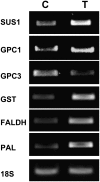The molecular basis of shoot responses of maize seedlings to Trichoderma harzianum T22 inoculation of the root: a proteomic approach
- PMID: 18562766
- PMCID: PMC2492612
- DOI: 10.1104/pp.108.123810
The molecular basis of shoot responses of maize seedlings to Trichoderma harzianum T22 inoculation of the root: a proteomic approach
Abstract
Trichoderma spp. are effective biocontrol agents for several soil-borne plant pathogens, and some are also known for their abilities to enhance systemic resistance to plant diseases and overall plant growth. Root colonization with Trichoderma harzianum Rifai strain 22 (T22) induces large changes in the proteome of shoots of maize (Zea mays) seedlings, even though T22 is present only on roots. We chose a proteomic approach to analyze those changes and identify pathways and genes that are involved in these processes. We used two-dimensional gel electrophoresis to identify proteins that are differentially expressed in response to colonization of maize plants with T22. Up- or down-regulated spots were subjected to tryptic digestion followed by identification using matrix-assisted laser desorption/ionization tandem time-of-flight mass spectrometry and nanospray ion-trap tandem mass spectrometry. We identified 91 out of 114 up-regulated and 30 out of 50 down-regulated proteins in the shoots. Classification of these revealed that a large portion of the up-regulated proteins are involved in carbohydrate metabolism and some were photosynthesis or stress related. Increased photosynthesis should have resulted in increased starch accumulation in seedlings and did indeed occur. In addition, numerous proteins induced in response to Trichoderma were those involved in stress and defense responses. Other processes that were up-regulated were amino acid metabolism, cell wall metabolism, and genetic information processing. Conversely, while the proteins involved in the pathways noted above were generally up-regulated, proteins involved in other processes such as secondary metabolism and protein biosynthesis were generally not affected. Up-regulation of carbohydrate metabolism and resistance responses may correspond to the enhanced growth response and induced resistance, respectively, conferred by the Trichoderma inoculation.
Figures


Similar articles
-
The relationship between increased growth and resistance induced in plants by root colonizing microbes.Plant Signal Behav. 2008 Sep;3(9):737-9. doi: 10.4161/psb.3.9.6605. Plant Signal Behav. 2008. PMID: 19704844 Free PMC article.
-
Secretome of Trichoderma interacting with maize roots: role in induced systemic resistance.Mol Cell Proteomics. 2015 Apr;14(4):1054-63. doi: 10.1074/mcp.M114.046607. Epub 2015 Feb 13. Mol Cell Proteomics. 2015. PMID: 25681119 Free PMC article.
-
Differential expression of maize chitinases in the presence or absence of Trichoderma harzianum strain T22 and indications of a novel exo- endo-heterodimeric chitinase activity.BMC Plant Biol. 2010 Jul 1;10:136. doi: 10.1186/1471-2229-10-136. BMC Plant Biol. 2010. PMID: 20594307 Free PMC article.
-
Host-specific transcriptomic pattern of Trichoderma virens during interaction with maize or tomato roots.BMC Genomics. 2015 Jan 22;16(1):8. doi: 10.1186/s12864-014-1208-3. BMC Genomics. 2015. PMID: 25608961 Free PMC article.
-
Maize-Pathogen Interactions: An Ongoing Combat from a Proteomics Perspective.Int J Mol Sci. 2015 Nov 30;16(12):28429-48. doi: 10.3390/ijms161226106. Int J Mol Sci. 2015. PMID: 26633370 Free PMC article. Review.
Cited by
-
Trichoderma-plant-pathogen interactions: advances in genetics of biological control.Indian J Microbiol. 2012 Dec;52(4):522-9. doi: 10.1007/s12088-012-0308-5. Epub 2012 Sep 29. Indian J Microbiol. 2012. PMID: 24293705 Free PMC article. Review.
-
Nitrogen Metabolism and Growth Enhancement in Tomato Plants Challenged with Trichoderma harzianum Expressing the Aspergillus nidulans Acetamidase amdS Gene.Front Microbiol. 2016 Aug 3;7:1182. doi: 10.3389/fmicb.2016.01182. eCollection 2016. Front Microbiol. 2016. PMID: 27536277 Free PMC article.
-
Genome Mining from Agriculturally Relevant Fungi Led to a d-Glucose Esterified Polyketide with a Terpene-like Core Structure.J Am Chem Soc. 2023 Nov 22;145(46):25080-25085. doi: 10.1021/jacs.3c10179. Epub 2023 Nov 10. J Am Chem Soc. 2023. PMID: 37948671 Free PMC article.
-
Endophytic Association of Trichoderma asperellum within Theobroma cacao Suppresses Vascular Streak Dieback Incidence and Promotes Side Graft Growth.Mycobiology. 2016 Sep;44(3):180-186. doi: 10.5941/MYCO.2016.44.3.180. Epub 2016 Sep 30. Mycobiology. 2016. PMID: 27790069 Free PMC article.
-
A Comparative Analysis of Microbe-Based Technologies Developed at ICAR-NBAIM Against Erysiphe necator Causing Powdery Mildew Disease in Grapes (Vitis vinifera L.).Front Microbiol. 2022 May 17;13:871901. doi: 10.3389/fmicb.2022.871901. eCollection 2022. Front Microbiol. 2022. PMID: 35663883 Free PMC article.
References
-
- Alfano G, Ivey MLL, Cakir C, Bos JIB, Miller SA, Madden LV, Kamoun S, Hoitink HAJ (2007) Systemic modulation of gene expression in tomato by Trichoderma hamatum 382. Phytopathology 97 429–437 - PubMed
-
- Baroja-Fernandez E, Munoz FJ, Saikusa T, Rodriguez-Lopez M, Akazawa T, Pozueta-Romero J (2003) Sucrose synthase catalyzes the de novo production of ADPglucose linked to starch biosynthesis in heterotrophic tissues of plants. Plant Cell Physiol 44 500–509 - PubMed
Publication types
MeSH terms
Substances
LinkOut - more resources
Full Text Sources
Other Literature Sources
Miscellaneous

